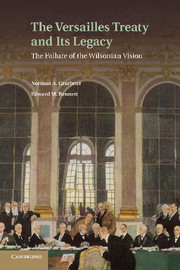Book contents
- Frontmatter
- Contents
- Preface
- 1 The International Order on Trial
- 2 The Road to Paris: 1917???1918
- 3 Versailles: A Study in Arrogance
- 4 The Retreat to Utopia
- 5 Manchuria and the Triumph of Non-Recognition
- 6 The Rise of Hitler
- 7 Challenge of the Dictators
- 8 The Elusive Response
- 9 Munich: The Continuing Escape from Reality
- 10 The Road to Prague
- 11 The Soviet Quest for Collective Security
- 12 The Coming of War: 1939
- Bibliography
- Index
- References
7 - Challenge of the Dictators
Published online by Cambridge University Press: 07 October 2011
- Frontmatter
- Contents
- Preface
- 1 The International Order on Trial
- 2 The Road to Paris: 1917???1918
- 3 Versailles: A Study in Arrogance
- 4 The Retreat to Utopia
- 5 Manchuria and the Triumph of Non-Recognition
- 6 The Rise of Hitler
- 7 Challenge of the Dictators
- 8 The Elusive Response
- 9 Munich: The Continuing Escape from Reality
- 10 The Road to Prague
- 11 The Soviet Quest for Collective Security
- 12 The Coming of War: 1939
- Bibliography
- Index
- References
Summary
I
Adolf Hitler’s decision to leave the Geneva Disarmament Conference and the League of Nations revealed his intentions to scrap the Versailles Treaty and launch an aggressive campaign against its provisions. This entailed enlisting Mussolini to his cause. First, however, he needed to be in a position to overwhelm foreign foes who would try to hold Germany to the inferior position it had occupied during the first post-war decade. He began this process by addressing the Reichstag in May 1933, informing its members that Germany would not demand equality of armaments for four years, but would sign no agreement that perpetuated the military inequality. Inside Germany, he began to implement his program, set forth in Mein Kampf, with speeches that emphasized German nationalism and militarism. His anti-Semitic Nuremberg Laws sent a stream of talented Jews out of the country.
Hitler’s open campaign against Versailles began in July 1934 with his dramatic move to annex Austria. The effort failed. The attempted coup resulted in the assassination of Austrian Chancellor Engelbert Dollfuss. It produced no annexation, but it exposed Hitler’s expansionist program. Ironically, this move frightened future ally Benito Mussolini, because German possession of the Brenner Pass would give Hitler an open route to northern Italy. Mussolini need not have worried. Hitler’s emphasis on Lebensraum strengthened his drive for an Italian alliance, while Mussolini’s designs in the Mediterranean placed him at odds with France. This gave Germany and Italy a common potential enemy. Hitler, moreover, was an early admirer of Mussolini and his Fascist program. The more Mussolini was attacked by “liberal” elements in Germany and elsewhere, the more Hitler desired to cement an alliance. Hitler’s later support of Mussolini’s adventure in Abyssinia helped to bring the two dictators together.
- Type
- Chapter
- Information
- The Versailles Treaty and its LegacyThe Failure of the Wilsonian Vision, pp. 124 - 140Publisher: Cambridge University PressPrint publication year: 2011



